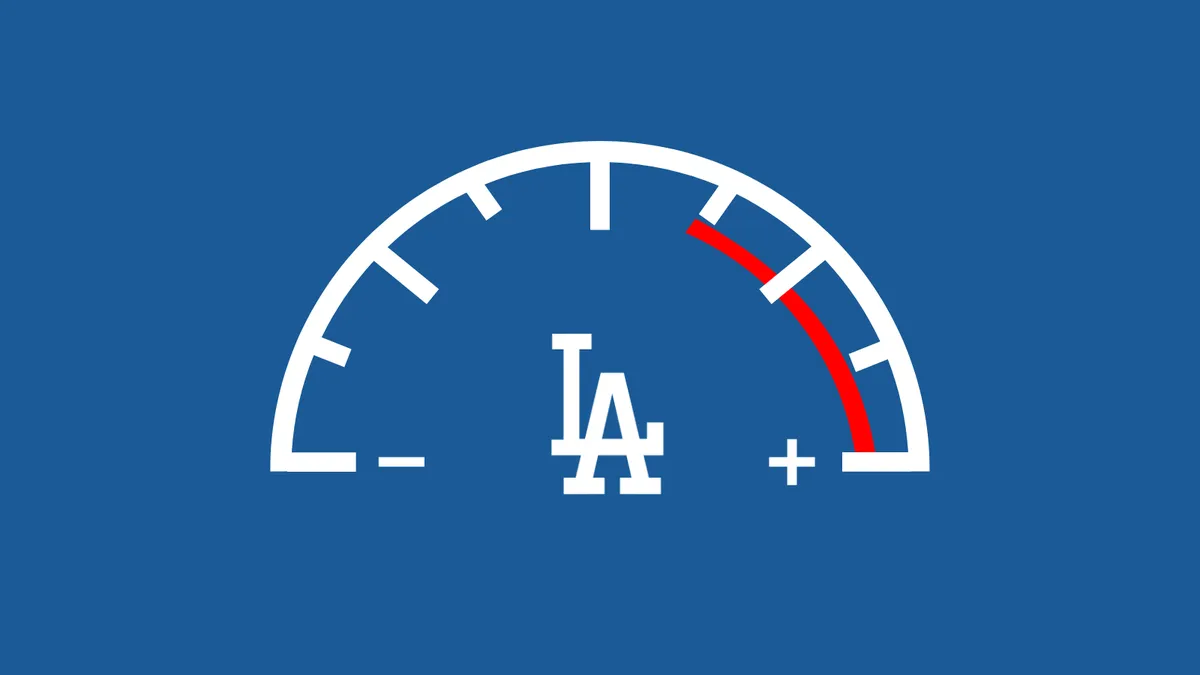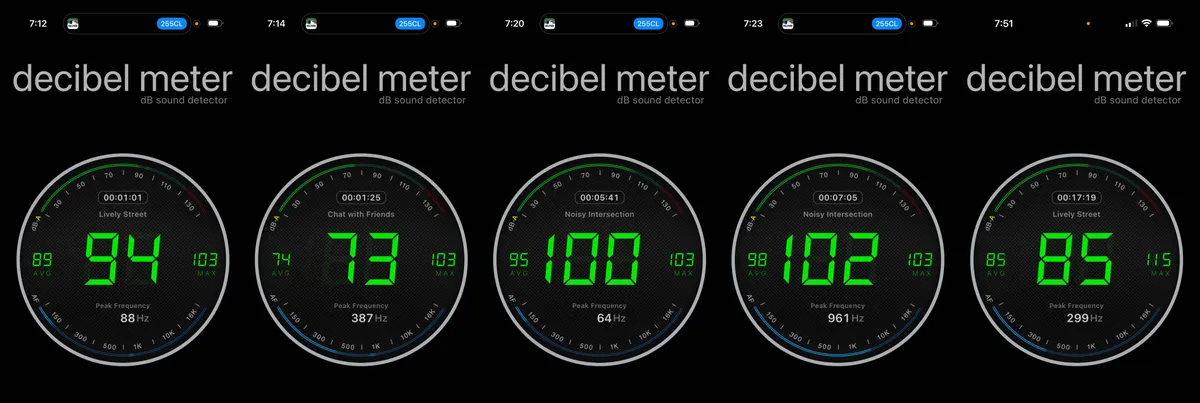Dodger Stadium is TOO LOUD

On Monday night, the Los Angeles Dodgers and the Toronto Blue Jays battled for six hours and 39 minutes in Game 3 of the World Series until Freddie Freeman ended it with a walk-off home run in the bottom of the 18th inning. The place went wild. The crowd went bananas. The decibel level was certainly booming...
Because the decibel level at Dodger Stadium is always booming, World Series heroics or not. It’s booming if they’re winning. It’s booming if they’re down by 10. It’s booming on Tuesday in late July with a half-empty house. The standard operating procedure at Dodger Stadium is seemingly to never let the decibel level drop under 90dB.
I have the data to back it up. This summer, we took a family trip to a Dodgers game. Aunts, uncles, cousins, nieces, nephews—the whole 40-man roster. We sat in Section 255, which was incidentally the number of chicken tenders we consumed, and left at the end of the sixth inning because the kids thought it was too loud. The children! Now, while I am admittedly making my way over to the porch to start my Get Off My Lawn Era—I’m not there just yet. The game was too loud.
Before we beat the traffic, I downloaded an app at the ballpark that measures decibel levels. I specifically chose the app Decibel Meter because it met my rigorous standards of being the first app that I found. I took various screenshots throughout the game, then tested a blender at home the next day to calibrate.
Here are the results:
| Event | dB | Equivalent Sound |
|---|---|---|
| Normal gameplay | 73 dB | Chat with friends |
| Blender in a spacious kitchen | 85 dB | Lively street |
| 80s synth music between innings | 94 dB | Noisy intersection |
| Quiz show between innings | 100 dB | Noisy intersection |
| A clutch Dodgers base hit | 102 dB | Noisy intersection |

We’re not the only ones with ringing ears. It turns out that earlier this year, Bill Shaikin investigated this for the Los Angeles Times. In his piece, aptly titled Why is Dodger Stadium SO LOUD?, he visited the three ballparks in Southern California and found: “It’s pleasant at Angel Stadium, lively at Petco Park, booming at Dodger Stadium.”
As Shaikin points out:
“Decibel levels are measured logarithmically, so an increase of 10 dB means sound is heard 10 times louder and an increase of 20 dB means sound is heard 100 times louder.”
I’m not a sound scientist, but ChatGPT tells me:
100 dB is 316 times more intense than 75 dB. In terms of perceived loudness to the human ear, it would sound roughly three to four times louder.
(ChatGPT also tells me that a sound scientist is more commonly called an “acoustician”.)
My decibel measurements more or less tracked with Shaikin’s. They seemed routinely in the 80s and 90s, and both peaked at over 100 dBs during exciting plays. But Shaikin also found that pregame events at Dodger Stadium registered in the 80s. Here he is describing the unpleasant atmosphere:
There is always something happening before the game in the center-field plaza: a band, product giveaways, Instagram-worthy photo opportunities, the live pregame broadcast for SportsNet LA. You can get hyped there, if you like. Or you can enjoy a conversation with your friends in your seats, instead of getting a headache before the game even starts.
Except, you can’t actually enjoy a conversation with your friends in your seats for the same reasons you can’t enjoy a conversation with your friends while the 85dB blender is running.
You'll notice on my chart that the quietest part of the game is during the game. This was the only time the volume dropped down into conversational territory. The result is that the only time you can talk with the people you came to the game with is the one time you want to shut up and watch the game.
Chatter is a fundamental component of the baseball tradition and experience. The infield fly rule was invented to give us something to talk about. If I wanted to go to a game where it was impossible to speak to another living soul, I’d go to Oakland.
To be fair, the loudest part of the game is also during the game. The difference is that when the stadium erupts because someone just hit a game-tying single, it’s an organic experience as opposed to the synthetic thunder of a Jumbotron quiz show. One is the sound of 50,000 fans each individually deciding to cheer at the exact same moment. The other is a guy with his finger on a button: Everybody dance now!
And it’s not just annoying—it actually takes the wind out of the naturally exciting moments of the game. When everything is loud, nothing is loud. Or maybe I’m wrong and a 445 foot Ohtani home run is just as exciting as a blinking ‘GET LOUD!’ graphic.
Baseball needs more organic noise. (And while we’re at it: more organ).
The Dodgers, to their credit, don’t deny it. They crank up the volume on purpose. And they friggin’ love it.
“We don’t make it louder just to make it louder,” said Lon Rosen, the Dodgers’ executive vice president and chief marketing officer. “It’s all part of what fits in the presentation.”
Mookie Betts agrees. “There is no ‘too loud,’” he says. “It’s all part of an entertainment show.”
And that would be fine if the ‘entertainment show’ was about the ‘presentation’ of a baseball game. But it’s not. Going to a game at Dodger Stadium doesn’t feel like going to a baseball game—it feels like going to the taping of a game show where during commercial breaks they play a little baseball.
Critics of this position might argue: They’re just trying to make baseball more fun. What’s so wrong with that? For instance, Clayton Kershaw says “The louder, the more fun, the better.”
To that, I say:
First of all, louder doesn’t mean better. Exhibit A: My children at Target.
Second, I might argue that the recent baseball reforms are not actually about making the game more fun. (After all, if you don’t think the game of baseball is fun, you’re not watching to begin with.) Many of the baseball reforms seem to be aimed at making the experience of watching baseball less burdensome.
And it’s working. Fewer mound visits, quicker deliveries, less fussing with batting gloves. They ’re letting the charm of the game come through by trimming the fat, not by adding noise.
Here is Shaikin one last time:
The Dodgers’ pregame show attempts to force anticipation upon the audience, as if that is somehow necessary. It’s not. You’re about to see Shohei Ohtani!
Exactly. At a half of a billion dollars, the Dodgers have the highest payroll in baseball. They should have no trouble generating their own decibels.
And they don’t. They’re in the World Series again. And if this trend keeps up, it won’t be long before the baseball quants start tracking metrics like ‘Wins per Decibel’ (WdB). And then each stadium will deploy their own corps of audio engineers. And then we’ll all be thrust into some sort of acoustic arms race. And when this happens, we will all lose—and not just our hearing.
I was there the last time the Blue Jays were in the World Series. 1993. Veterans Stadium. Philadelphia, PA. Our neighbor had tickets. I was six years old. I don’t remember which game it was (3 or 4?) or who won. What I do remember is how the stadium erupted after some random clutch Phillies hit. The sound thundered off the concrete. It was pure, organic pandemonium.
The sound system was there, too. But it didn’t interject. It rode the wave and punctuated the moment with a timely “Whoomp! (There It Is)”. And when the cheering died down, it was at least quiet enough for a dad to lean over to his six-year-old son and explain exactly what all this whoomping was about. ⚑
Loose Change
- Here are some responses to Shaikin’s piece in the Los Angeles Times. They all take his side.
- Here’s a Reddit threat with even more complaints about the Dodgers sound system.
More posts on sports: